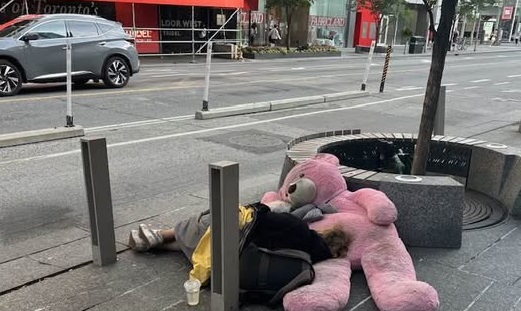By Kathy Mochnacki

Supplied photo – homeless person in the very expensive Bloor Yonge Yorkville shopping area of Toronto
Despite York Region in Ontario having very hardworking municipal politicians, people who are admired for their sincerity and interest in the welfare of our community, it appears they would prefer to be seen getting things done rather than getting them done properly.
When it comes to mental health planning, politicians should have a knowledge of mental illness literacy and know about past mental health planning and policies. It means having a clear vision of a project and the people that it will serve.
This is something that has never happened when it comes to the planning of the York Region Mental Health Community Centre. There has been no clear vision or an understanding of the people that it will serve.
These are standard requirements for any planning:
- A clear understanding of the goal.
- A clear understanding of the current circumstances.
- A clear understanding of the future circumstances once the goal is achieved.
- A clear understanding of the steps needed to get to that future.
- A clear understanding of the payoffs of getting there.
It is not clear that any of these standards have been considered.
The general public first learned about a community mental health centre when the former Aurora MPP and Health Minister Christine Elliott announced in 2020 that “York Region residents living with mental health and addiction concerns will be able to turn to a crisis hub in the future to help support their needs”.
It is now 2025 (5 years later), and the concept of this “Hub” has undergone a number of changes. First, the name was changed to the York Region Mental Health Community Centre. Did the name happen because it was pointed out that a tax funded 2019 Report written by Jim Cressos of the Canadian Mental Health Association York (CMHA), the lead agency and not online, recommended pro-active services be developed rather than crises services. It states:
“This Report identified that there is “a recognized service system gap for people with mental health and/or addictions challenges that (sic) either lack access to adequate housing or are not receiving the suitable supports relating to their mental health and/or addictions in their housing situation”.
This is the current circumstance and presumably the goal is to resolve this lack of access and needed supports.
But what CMHA conveniently ignore is if people are not in housing and are not receiving “suitable supports” where are the supports that this Hub will now be referring people to? And what housing will there be for them?
They either aren’t there or they are too few for the need. The goal should be to ensure these people do have housing and supports.
Then, we learned that the Hub is for voluntary patients only. This essentially leaves out the most needy of mental health patients referred to in their own report – those not in housing or lacking access to suitable supports. These are usually people with psychotic illnesses many of whom have anosognosia or no insight that they are ill. It would be challenging for them to accept medical intervention voluntarily given that their illness prevents them for recognizing that they are ill. Conservative estimates state that 30% of homeless people have untreated psychosis.
Does being untreated and homeless not represent a crisis? Just look at the numbers in most cities in Canada living on the streets for the answer.
In the most recent press release, we learn that there will be only be only up to 10 beds rather than the original 20 beds. Have the planners decided to not have the 10 addiction beds because the proposed centrally located Newmarket based Hub has caused concerns among local residents who fear that they would be inundated with drug paraphernalia left on the streets and drug dealers?
It is also doubtful if a short stay program would meet the needs of people suffering from addiction. This press release is different from the one issued by local Newmarket MPP Dawn Gallagher Murphy who states that there are 20 beds. What kind of planning is this when public statements about the number of beds are inconsistent?
According to a 2024 York Region Report entitled Report of the Acting Commissioner of Community and Health Services Capital Contribution for Mental Health Community Care Hub as a Funding Grant, (not online) the Hub is to be developed because “research shows that emergency departments are not always the optimal care setting for residents experiencing mental health and addictions issues. A critical gap in the mental health system is a lack of access to specialized emergency mental health care”.
What research is this? It needed to be named and linked in this Report if the Report is to have any credibility.
Such a statement is startling in its reasoning that the Hub “will fill a current gap in mental health services by providing residents with more timely access to dedicated mental health and addictions supports, and divert demand from local hospitals to free up resources for other needs”.
The reason why emergency wards in our local hospitals do not provide optimal mental health care is because there is a chronic lack of psychiatric beds and a lack of appropriate community resources to discharge patients to. Recently, a psychiatrist in one of the local hospital complained about leaving at 3am in the morning when there were patients still waiting for beds! The actual “critical gaps” in services began with the lack of psychiatric beds. It makes more sense to spend precious mental health dollars on our local hospitals which already have resources such as pharmacies, and medical care on site for the patients which this new Hub will not have.
As Dr. David Laing Dawson said in his blog on the hub, this is a waste of time and money and a disaster waiting to happen. “Such an isolated 10 bed facility cannot investigate, diagnose, treat, keep safe someone in the throes of psychosis.
So who will they serve with those ten beds? Likely someone needing a bed, and three meals, for the night or week during a cold spell in the winter. Fair enough. But this then is a very expensive motel.”
The Ontario government has already spent $200,000 to support the planning and development of this facility. In addition, $5 million has been transferred from the York Region Reserve fund to CMHA York. With the latest announcement, we understand that a further $1,095,100 will be coming from the Ontario Government, with the understanding that more funds will be on the way.
We are looking at a total expenditure of $6,295,100 plus for maybe 10 or maybe 20 beds for people who do not have serious mental illnesses. If 10 patients, that’s $630K per patient before even costing the actual care.
In the interests of transparency, a freedom of information (FOI) request has been made to York Region to determine what criteria are needed to access the York Region Reserve Fund. It would also be helpful to know how much taxpayers in other communities of York Region are paying towards the Hub, which looks more and more like an annex of Southlake Hospital in Newmarket. The Region responded that they will answer the request August 5.
An FOI request has also been submitted to CMHA York to determine the total cost of this facility. York Region supplied the name of the FOI co-ordinator but he did not reply as he is required to do if they come under FOI legislation. Instead, a reply from the director of communications saying they will not give any information as it is considered proprietary. She said:
“We’ve been working with the Ministry of Health Capital Branch, Ontario Health Central Region and the Ministry of Mental Health and Addictions throughout this phase of the project. Detailed budgets, cost projections and associated planning documents will not be made publicly available. These materials are considered proprietary and form part of the Ministry of Health’s capital planning and approvals process.”
How could public spending on a public project be proprietary?
Seeking further details from CMHA-York, we were told that “CMHA is leading the project as a provincial Ministry Funded Project and all FOI requests must be obtained as per the appropriate channels directed in the previously provided email.” Even though CMHA is the lead agency, they refer questions back to the Ministry and reiterate that this is a proprietary project.
Family caregivers of those with severe mental illnesses from Vaughan and Richmond Hill communities of the York Region met with then Associate Minister of Mental Health and Addictions, Michael Tibollo and Richmond Hill MPP Daisy Wai in 2023 to express our concerns. CMHA York CEO, Rebecca Shields was invited but did not attend.
At that meeting, we asked if a Needs Assessment had been done in preparation for the development of the York Region Mental Health and Addictions Hub? If so what were the Recommendations? We asked that CEO Rebecca Shields provide the Needs Assessment. None was given so maybe it was not done which would be a huge failure.
In a video presentation to then Richmond Hill MP Majid Jowhari’s Health Council later that same year, CMHA CEO Rebecca Shields said 200 families had been consulted in the development of this Hub. A follow up e-mail to her asked who those 200 families were. In response, her assistant sent a glossy 2017 Brochure about the Hub but the question was not answered.
In a Newspaper article of September, 2024, Rebecca states “We’re going to try to stop the cycle of crisis….It’s comprehensive, it’s integrated. It’s what we’ve all been waiting for”. Should she and the politicians not know that the current crisis has been caused by, among other factors, the poorly planned policy of de-Institutionalization. According to a Report from the Canadian Institute for Health Information, there were 50,000 psychiatric beds in 1960 but only 7,200 psychiatric hospital beds in 2019. The resultant closure of psychiatric hospital beds sent thousands of patients back into the community where there were little supports. Many of those patients had psychotic illnesses, they were not patients with common depression and anxiety who are the people that the Hub will support.
In our 2023 Meeting with former Minister Tibollo and MPP Daisy Wai, we emphasized the need for supportive housing rather than a crisis hub and supported our request by citing recommendations from the 2019 CMHA York Report. Now the Mental Health Commission of Canada has also weighed in with its Report released on June 17th, which advises that “amid rising chronic homelessness and limited resources-especially for services supporting mental health and substance use health-there is a growing need to prioritize flexible, cost-effective, and evidence-informed interventions like Housing First, a proven, evidence-based approach that provides people experiencing homelessness with permanent housing and access to health services.
Homelessness in York Region is growing like it is all over Canada. The number of encampments in the Region has gone from 62 in 2021 to 361 in 2024.
It would make more sense to use the current Provincial Funding that Newmarket MPP Dawn Gallagher Murphy has successfully solicited and allocate it to building permanent housing in York Region, rather than this Hub, A place to start would be to renovate the former Thrift Store at Yonge and Gladman Avenue in Newmarket into permanent housing instead.
This would make a real difference and impact upon the current Crisis. This is what families want. It is also what the Mental Health Commission of Canada recommends.
Kathleen Mochnacki is President of the Family Alliance on Severe Mental Illnesses, an organization that asks that families be key stakeholders in the design and maintenance of healthcare systems that provide for their loved ones, and consequently must have a seat at all tables where decisions are made about services and legislation for individuals suffering from psychotic illnesses.










